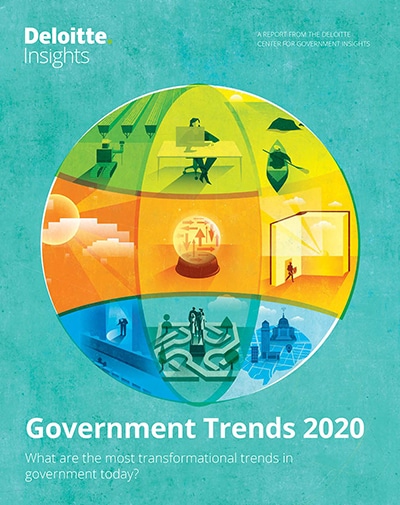
The digital citizen Improving end-to-end public service delivery via a unique digital identity
6 minute read
24 June 2019
Imagine logging into a government website the way you log into your bank account. A unique digital identity, increasingly being adopted globally, can streamline citizens' and businesses' interactions with government.
What if government could authenticate citizens—and businesses—the same way that most digital companies do their customers?
Imagine logging into government the way you log into your bank account. A land developer could, for example, upload blueprints, check the status of a building inspection, and then click another tab to apply for government grants. A homeowner could apply for an easement, buy a bus pass, and then pay taxes, all in one place. A unique digital identity could enable all of this and eliminate the need for citizens and businesses that opt in to provide the same information again and again to different government agencies.
For decades, governments have relied on a sprawling patchwork of systems to identify and manage people, using everything from passwords and smart cards to biometrics; moreover, in developing countries more than a billion people around the world have no formal way of proving their identity.1 A unique digital identity for citizens could enable dramatic leaps in service quality and massive efficiency gains for governments, as well as drive financial and social inclusion by providing citizens access to health care, education, and other government benefit programs.2 This model is beginning to be adopted across the world.
An advanced model in Estonia. Estonia’s digital infrastructure enables every part of the government to easily identify citizens and offer services more efficiently. Basic citizen information is entered just once and shared across agencies. As a result, an Estonian citizen preparing his or her taxes starts with a prepopulated tax form, rather than a blank slate. Moreover, Estonians can vote online, access their e-health records, and conduct just about every government transaction online (barring marriage, divorce, and real-estate transactions).3 Estonia even allows citizens of other countries to become an “e-resident” of the country to make it easier to do business in Estonia.
The European Union is heading down a similar path.

An intercontinental identity. The EU Once-Only project has a pivotal role to play in creating a digital single market across the continent. As the name suggests, the goal of the initiative is that citizens and businesses need only provide their information to government once, thus reducing administrative burdens and facilitating the ease of doing cross-border business.4 The project will also allow citizens and businesses to use their respective national electronic IDs to seamlessly access public services in other parts of the European Union.5
The world’s largest digital identity program. A number of developing economies—including Peru, Uruguay, Chile, the Philippines, Thailand, Indonesia, and Pakistan—have launched digital identity programs.6 India’s Aadhaar program is the world’s largest digital identity program, providing a unique 12-digit identifier assigned to each of its 1.3 billion citizens based on their biometric and demographic data.7
The Indian government launched the Jan Dhan-Aadhaar-Mobile (JAM) initiative in 2014–2015,8 aiming to link Jan Dhan bank accounts, Aadhaar, and mobile numbers to plug any potential leaks in government benefit programs. The linkages have made Aadhaar-based verification easier and helped millions of Indians enter the formal banking system for the first time. Now, more than 80 percent of Indian adults have a bank account, compared with just 35 percent in 2011.9
Health cards as key lever. Some governments are using universal health insurance cards as the key lever for unique digital identities. British Columbia, for example, replaced its legacy CareCards with BC Services cards to access publicly funded health services. The card also acts as an authenticator to access other public services online.10
Unique digital identities for business. Some countries are also focusing on easing business by assigning companies unique digital identities. For example, New Zealand launched a program to assign a 13-digit unique identifier number to businesses operating within its borders. The identifier number is associated with basic business data such as address, phone number, and the business’s trading name, so businesses need not furnish this information every time they interact with government agencies: The information will be prepopulated every time they enter the number in any form. The number will also facilitate e-invoicing of payments and receipts between two different business entities.11 The unique identifier initiative is expected to save businesses up to US$60 million annually.12
Unique digital identity epitomizes the idea that the future is here, but it’s just unevenly distributed. While many countries have made great strides in this area, others, have not. Governments that have been slower to gain traction and acceptance of government-issued (or approved) digital identities have encountered two main challenges: trust and federated political systems.
Trust in government. Would you trust your government to build an identity management system that helps join the dots on personal data such as tax filings, driver’s licenses, health records, land records, and other personally identifiable information? The answer might depend on which part of the world you are from. In some countries, such as Switzerland and Indonesia, trust in government is high, while in many others, trust in government is quite low.13 Trust can be of paramount importance for getting citizen buy-in for the universal digital identity system, since it raises thorny questions about data ownership, data privacy, and data-sharing. In low-trust environments, political opposition can derail the drive for digital identity.
Integrating identity systems across levels. Political and governmental structures may prevent some countries from moving toward a national digital identity and instead opt for a federated system with multiple IDs across government levels. For instance, Australia has multiple IDs across different government tiers including the Federal Digital Transformation Agency14 and the state of New South Wales.15 In the United States, many states have their own state-specific identity management systems, such as MILogin for the state of Michigan16 and OH|ID for the state of Ohio.17
Tackling these thorny issues continues to be a challenge for many countries.
Data signals
- An estimated US$1B was saved on civil service staff in Nigeria using digital IDs, which removed 62,000 ghost workers.18
- Twenty-four of 28 EU member countries have begun implementing the Once-Only initiative, which is expected to save 855,000 hours for citizens and 11 billion euros for businesses annually.19
- Estonia’s use of digital signatures helped achieve 2 percent in annual GDP savings.20
- Worldwide, 1 billion people lack access to a legal way to identify themselves.21
Moving forward
- Formulate a legal and policy framework that defines scope, objectives, and institutional accountability.
- Establish privacy-by-design principles and frameworks that protect user privacy and citizen rights.
- Develop a multiyear road map for integrating essential government services with the digital identity system.
- Consider technologies and ways in which a citizen can authenticate identity: smart cards, biometrics, iris scan, facial recognition, and mobile app, among others.
Potential benefits
- Reduce friction while interacting and transacting with government;
- Lower administrative costs;
- Improve ease of doing business;
- Provides foundation for digitally unifying markets;
- Reduce fraud and waste; and
- Accelerate citizen-first digital transformation.
Risk factors
- Growing risk of state surveillance; and
- Cybersecurity and privacy concerns.
Read more about how governments are approaching digital transformation in the Digital government transformation collection.
Explore the collections
-
Innovation accelerators Article5 years ago
-
Nudging for good Article5 years ago
-
Citizen experience in government takes center stage Article5 years ago
-
Smart government Article5 years ago
-
The rise of data and AI ethics Article5 years ago
-
Government Trends 2024 Article7 months ago

















